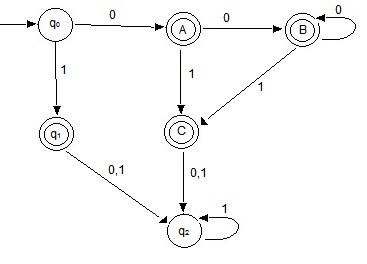Algorithm
Let M2 = {Q2, Σ, δ2, F2, q’0} be NFA that recognizes the language L and M = {Q, Σ, δ, F, q0} be the corresponding DFA. To obtain the DFA we may proceed as follows:
- Initially Q = Φ.
- Put q’0 into Q. q’0 is the initial state of the DFA M.
- Then for each q in Q do the following: add this new state, add δ(q, a) =Upϵq δ2(p, a) to δ. The state added to Q is a subset of states of NFA.
- Repeat step 3 till new states are there to add in Q, the process terminates when there is no new state after step 3.
Note:The states added to Q with the final state of M2 in the set of states are final states of the DFA.
Example: Convert the following NFA into DFA

Solution
δ(q0, 0) = {q0, q1} = A*
δ(q0, 1) = {q1}*
Add states A and q1 to Q.
δ(A, 0) = δ({q0, q1}, 0) = δ(q0, 0) U δ(q1, 0)
= {q0, q1} U {q2} = {q0, q1, q2} = B*
δ(A, 1) = δ({q0, q1}, 1) = δ(q0, 0) U δ(q1, 1)
= {q1, q2} = C*
δ(q1, 0) = q2
δ(q1, 1) = q2
Add B* C* and q2 to Q
δ(B, 0) = δ(q0, 0) U δ(q1, 0) U δ(q2, 0)
= {q0, q1, q2} = B*
δ(B, 1) = δ(q0, 1) U δ(q1, 0) U δ(2, 1)
= {q1, q2} = C*
δ(C, 0) = δ(q1, 0) U δ(q2, 1) = { q2} U {Φ}
= q2
δ(C, 1) = δ(q1, 1) U δ(q2, 1) = {q2} U {q2}
= q2
δ(q2, 0) = Φ
δ(q2, 1) = q2
No new states were generated so we stop the procedure. The star after the state represents the final state in Q. The DFA generated by the above procedure:

Sanfoundry Global Education & Learning Series – 100+ Theory of Computation Tutorials.
If you wish to look at all Tutorials and their examples, go to Theory of Computation Tutorials.
If you find any mistake above, kindly email to [email protected]
- Check Automata Theory Books
- Check Computer Science Books
- Practice Computer Science MCQs
- Apply for Computer Science Internship
